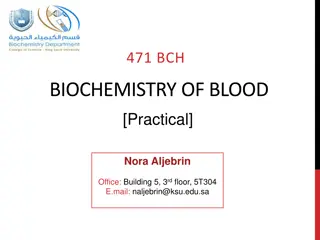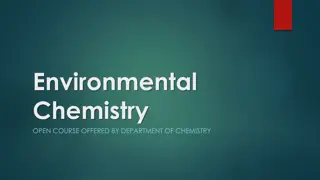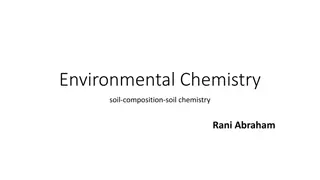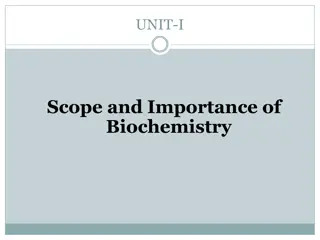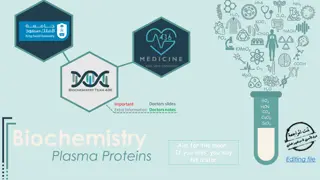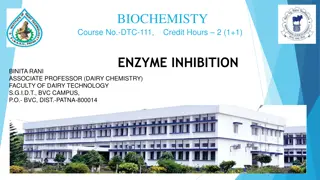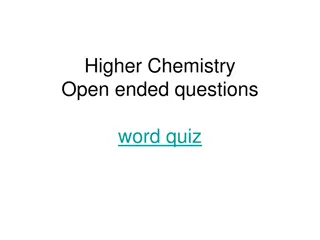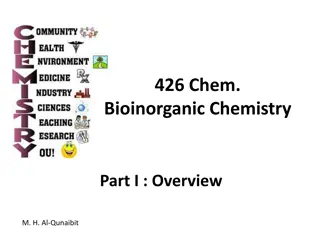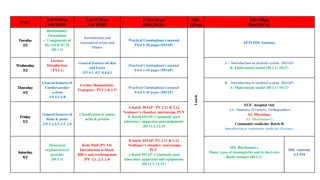Introduction to Biochemistry: Understanding the Chemistry of Life
Biochemistry is the science that delves into the chemical basis of life, focusing on cellular components, biomolecules, metabolism, gene expression, and more. Understanding biochemistry is crucial for comprehending the molecular processes associated with living cells, both in health and disease.
Download Presentation

Please find below an Image/Link to download the presentation.
The content on the website is provided AS IS for your information and personal use only. It may not be sold, licensed, or shared on other websites without obtaining consent from the author. Download presentation by click this link. If you encounter any issues during the download, it is possible that the publisher has removed the file from their server.
E N D
Presentation Transcript
Introduction to Biochemistry Lecture : 1 Dr. Shaimaa Munther
BIOCHEMISTRY Reference texts: Harpers edition Illustrated Biochemistry. 29th Biochemistry Lippincott s Illustrated Reviews. 6th edition
Introduction to Biochemistry Overview: What we mean by Biochemistry? What is the aim of Biochemistry? What dose the Biochemistry discuss? General review of biochemistry.
What is Biochemistry? Biochemistry = Chemistry of life Biochemistry can be defined as the science concerned with the chemical basis of life . Since cells are the structural units of living systems. Thus, biochemistry can also be described as the science concerned with the chemical constituents of living cells and with the reactions they undergo. Because life depends on biochemical reactions, biochemistry has become the basic language of all biologic sciences.
The Aim of Biochemistry The major aim of biochemistry is the complete understanding, at the molecular level, of all of the chemical processes associated with living cells. To achieve this objective, biochemists have sought to isolate the numerous molecules found in cells, determine their structures, and analyze how they function.
What dose the Biochemistry discuss? Biochemistry discusses: Structure and function of cellular components Proteins Carbohydrates Lipids Nucleic acids and other biomolecules Metabolism and Regulation Gene expression and modulation
Perhaps All Disease Has a Biochemical Basis. Knowledge of the biochemical molecules shown in the top part of the diagram has clarified our understanding of the diseases shown in the bottom half and conversely, analyses of the diseases shown below have cast light on many areas of biochemistry Examples of the two-way street connecting biochemistry and medicine
Starting materials: Elements of life Around 25 of the 94 naturally occurring chemical elements are essential to various kinds of biological life. Just six elements (carbon, hydrogen, nitrogen, oxygen, sulfur, & phosphorus ) make up almost 99% of the mass of a human cells. Life on earth depends on the chemical element carbon, which is present in every living thing.
Range of the sizes of objects studies by Biochemist and Biologist Biochemistry is concerned with the entire spectrum of life forms, from relatively simple viruses and bacteria to complex human beings. .
Organization of Life Elements Simple organic compounds (monomers) Macromolecules (polymers) Supramolecular structures Organelles Cells Tissues Organisms
Elements of Life Most abundant, essential for all organisms: C, N, O, P, S, H Less abundant, essential for all organisms : Na, Mg, K, Ca, Cl Trace levels, essential for all organism: Mn, Fe, Co, Cu, Zn Trace levels, essential for some organisms: V, Cr, Mo, B, Al, Ga, Sn, Si, As, Se, I.
Biomolecules of life There are 4 classes of biomolecules to be studied in this biochemistry course: 1. Proteins 2. Carbohydrates 3. Lipids 4. Nucleic acids
Many Important Biomolecules are Polymers Biopolymers are macromolecules created by joining many smaller organic molecules called (monomers) by a reaction named Condensation reactions (H2O is removed in the process). Each monomer in the polymer chain is a Residue.
Monomers and Polymers Macromolecule Monomer Carbohydrates Monosaccharide Lipids Not always polymers; Hydrocarbon chains Amino acids Proteins Nucleotides Nucleic acids
Carbohydrates glucose monomer Carbohydrates are made from monomers called monosaccharides. Some of these monosaccharides include glucose (C6H12O6), fructose (C6H12O6), and deoxyribose (C5H10O4) polymer cellulose supramolecular structure cell wall Glucose polysaccharide carbohydrate disaccharide
Carbohydrates Carbohydrates are the main source of energy for living organisms and are made of carbon, hydrogen, and oxygen. Chlorophyll in plants absorbs light energy from the sun. This energy is used in the process of photosynthesis, which allows green plants to take in carbon dioxide and release oxygen and allows for the production of carbohydrates. Plants transform carbon dioxide (CO2) from the air, water (H2O) from the ground, and energy from the sun into oxygen (O2) and carbohydrates.
Carbohydrates Humans and other animals obtain carbohydrates by eating foods that contain them. In order to use the energy contained in the carbohydrates, humans must metabolize , or break down, the structure of the molecule in a process that is opposite that of photosynthesis. It starts with the carbohydrate and oxygen and produces carbon dioxide, water, and energy. The body utilizes the energy and water and rids itself of the carbon dioxide.
Carbohydrates Functions Carbohydrates serve as energy source. Ribose and deoxyribose sugars form part of of RNA and DNA. Polysaccharides are structural elements in the cell . Carbohydrates are linked to many proteins and lipids, forming different molecular proteoglycans, the glycoproteins and the glycolipids. classes are the
2. Proteins monomer amino acid Proteins are large biomolecules, or macromolecules, consisting of one or more long chains of amino acid residues. Proteins perform a vast array of functions within including catalyzing reactions, DNA responding to transporting molecules from one location to another. polymer protein subunit supramolecular structure organisms, metabolic replication, stimuli, Enzyme complex and Amino acid Dipeptide Protein subunit Protein
Proteins Proteins are the most complex and varied class of molecules ; they are large polymer composed of carbon, nitrogen, oxygen and hydrogen. Upon hydrolysis proteins produce monomeric units called amino acids. Amino acids have amino group NH2- on alpha carbon atom located next to the carboxylic group.
Proteins Proteins are composed of 20 common amino acids Each amino acid contains: (1) Carboxylate group (-COO ) (2) Amino group (-NH2) (3) Hydrogen atom (- H) (4) Side chain (R) unique to each amino acid
Structure of an amino acid and a dipeptide (a) Amino group (blue), carboxylate group (red) (b) Dipeptides are connected by peptide bonds
3- Lipids fatty acid monomer lipids comprise a group of naturally occurring molecules that include fats, waxes, sterols, fat-soluble vitamins (such as vitamins A, D, E, and K), triglycerides, phospholipids, cholesterol and others. The main biological functions of lipids include storing energy, signaling, and acting as structural components membranes. phospholipid polymer supramolecular structure membrane of cell Supramolecular structure Fatty acid Phospholipids
Lipids Lipids are rich in carbon and hydrogen, but contain little oxygen Lipids are not soluble in water Fatty acids are the simplest lipids: long chain hydrocarbons, with a carboxylate group at one end Fatty acids are often components of glycerophospholipids
Model of a Membrane lipid Phospholipids composed from a Hydrophilic (water-loving) interacts with Hydrophobic (water-fearing) tail head H2O and a A biological memberane composed from a lipid bilayer with associated proteins usually
4. Nucleic Acids A nucleic acid is a large macromolecule or polymer composed of chain of monomeric nucleotides. These molecules carry the genetic information or form structures within the cells. Nucleic acids, present (deoxyribonucleic acid) and RNA (ribonucleic acid). Nucleic acids are among the most important biological macromolecules, they are found in abundance in all living things, where they function in encoding, expressing genetic information. monomer nucleotide polymer DNA as DNA supramolecular structure chromatin transmitting and supramolecular structure Nucleotide DNA strand
GENE EXPRESSION DNA GENE EXPRESSION PROTEIN
Note: Monomers form polymers through condensations Polymers down through hydrolysis. are broken
Anabolic Macromolecule Polysaccharide Protein (peptide) RNA or DNA Lipid Building block Simple sugar Amino acid Nucleotide Fatty acid Catabolic
Functional Groups in Biochemistry
Biomolecules Just like cells are building blocks of tissues, biomolecules are building blocks of cells. Animal and plant cells contain approximately 10,000 kinds of biomolecules. Water constitutes 50-95% of cells content by weight. Ions like Na+, K+and Ca2+may account for another 1%. Almost all other kinds of biomolecules are organic (C, H, N, O, P, S). Organic primarily of a Carbon skeleton. compounds are compounds composed
Carbon Carbon is more abundant in living organisms than it is in the rest of the universe. What makes Carbon Special? Why is Carbon so different from all the other elements on the periodic table? The answer derives from the ability of Carbon atoms to bond together to form long chains and rings. Carbon can form immensely diverse compounds, from simple to complex. DNA with tens of Billions of Carbon atoms Methane with 1 Carbon atom
Biomolecules are compounds of carbon with a variety of functional groups
Functional groups in biochemistry Functional groups - specific parts of molecules involved in biochemical reactions
Example : Functional groups in Acetyl- coenzyme A






